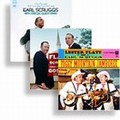
Flatt & Scruggs and Earl Scruggs – Foggy Mountain Jamboree, Gospel and I Saw The Ligh
It’s surprising that Legacy didn’t issue this bluegrass treasure trove closer to the heels of O Brother, Where Art Thou, the movie that introduced Ralph Stanley to a new generation and made Dan Tyminski a recognizable voice, if not face. But better late than never; music this good doesn’t carry an expiration date.
Indeed, although Foggy Mountain Jamboree was released in 1957, some of its 12 tracks (like “Earl’s Breakdown”) were recorded as far back as 1951, only three years after Lester Flatt and Earl Scruggs left the father of bluegrass, Bill Monroe. In those days, albums were typically collections of singles, but, at least for me, Jamboree sounds like a cohesive whole, maybe because it was in my father’s record collection, and was some of the first music that transfixed me. The inclusion of three bonus cuts makes this reissue that much more special.
From Scrugg’s familiar tuning-peg lick that opens “Flint Hill Special,” things are off to the races, with Flatt’s guitar and Curly Seckler’s mandolin pounding the rhythm, and Benny Martin’s fiddle and Scruggs’ banjo trading solos, each chorus taking flight from the one before it. Josh Graves’ Dobro joins in on “Some Old Day,” a perfect counterpart to the harmony vocals of Flatt and Seckler.
Other classics include “Randy Lynn Rag,” “Foggy Mountain Chimes,” and “Shuckin’ the Corn.” “Jimmie Brown, The Newsboy” and “It Won’t Be Long” feature Earl on lead guitar – an atypical role for the instrument in bluegrass at that time. To this day, bluegrass doesn’t get any better than this.
Gospel was always a component of Flatt & Scruggs’ live shows and recordings; indeed, religious music was an integral part of virtually every early country musicians’ background and repertoire. Legacy wisely compiled the duo’s sacred material on two jam-packed discs – 52 tracks worth of Foggy Mountain Gospel.
The compilation spans from 1951 to ’66, and includes several live tracks, as well as the albums Songs Of Glory and When The Saints Go Marching In. In this context, the group’s harmony vocals were showcased to their best advantage, but the group’s instrumental fireworks were solid bluegrass, as spirited as ever.
When Scruggs sought to expand his musical horizons (while Flatt wanted to adhere to bluegrass), the pair parted company in 1969. In ’71, Earl (then 47) went into the studio to record Saw The Light With Some Help From My Friends and proved that he and his banjo could be true to bluegrass traditions and in step with contemporary rock and country. It didn’t hurt that his sons had inherited a dollop of their dad’s talent – with Steve on keyboards, Gary on electric bass and vocals, and Randy, an 18-year-old flatpicking wiz at the time. Also lending a hand were guest vocalists Linda Ronstadt (on a beautiful rendition of Merle Haggard’s “Silver Wings”), Arlo Guthrie (on “Banks Of The Ohio”), and Tracy Nelson (on a haunting “Motherless Child Blues”). Nelson and Ronstadt duet on U. Utah Phillips’ moving “Rock Salt And Nails.” As if that weren’t enough, the Nitty Gritty Dirt Band and Norman Blake join an ensemble that already included the great Vassar Clements on fiddle.
It’s worth noting that Scruggs was merging bluegrass with rock at the same time that the Dirt Band was paying respect to their mentors (including Earl) with Will The Circle Be Unbroken . Both albums are still milestones.
This article originally appeared in VG‘s Oct. ’05 issue. All copyrights are by the author and Vintage Guitar magazine. Unauthorized replication or use is strictly prohibited.

